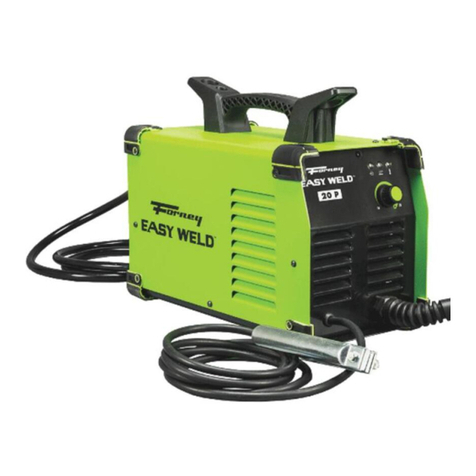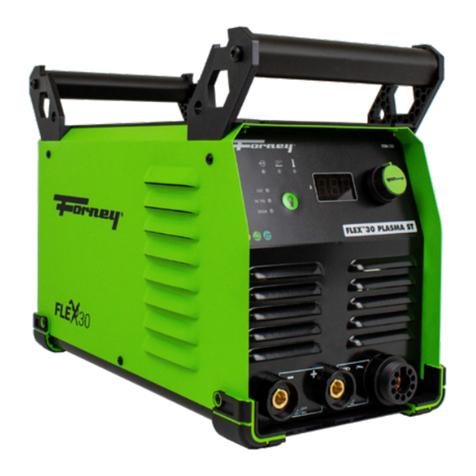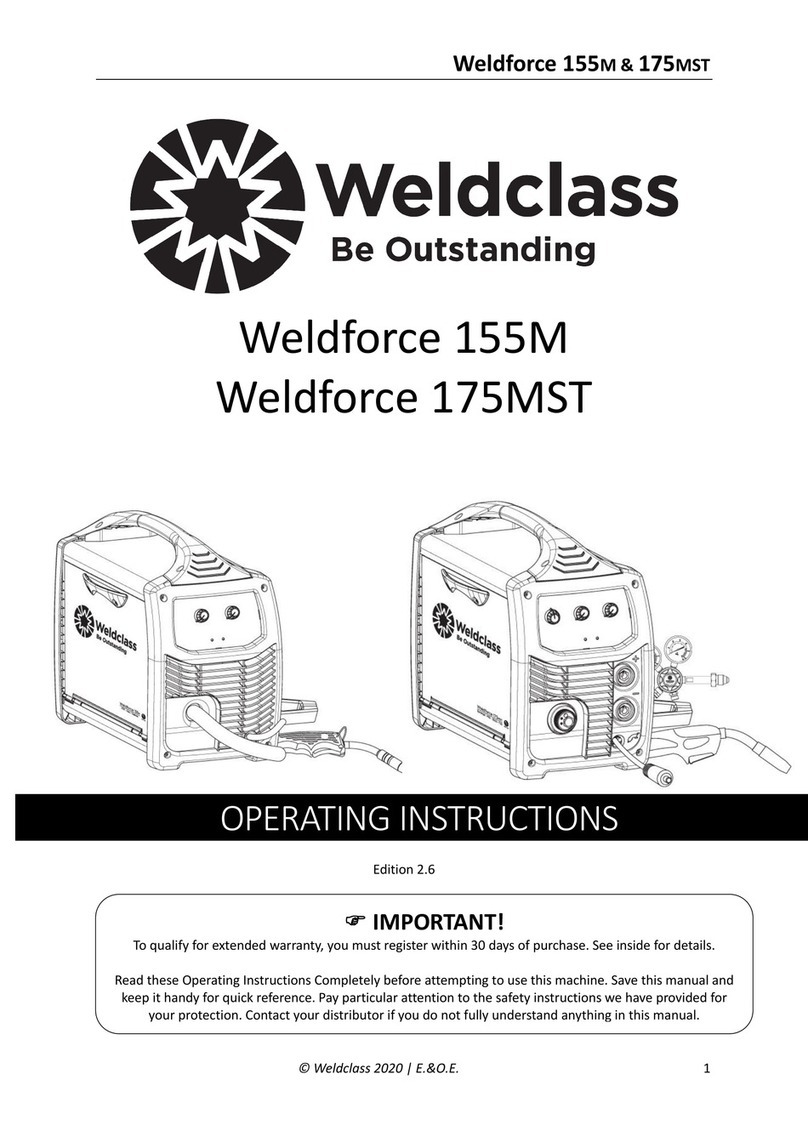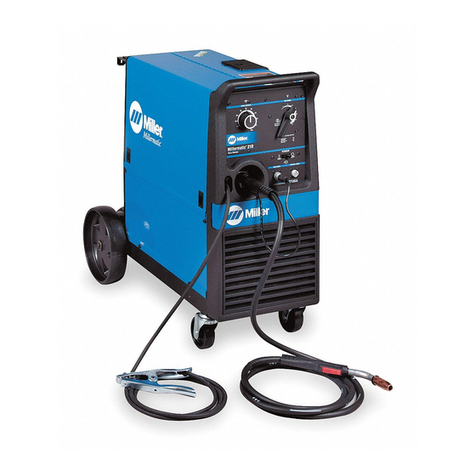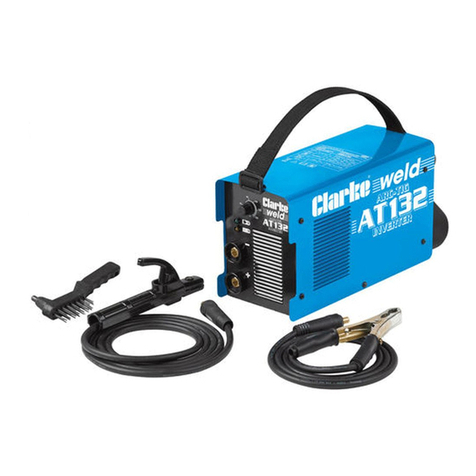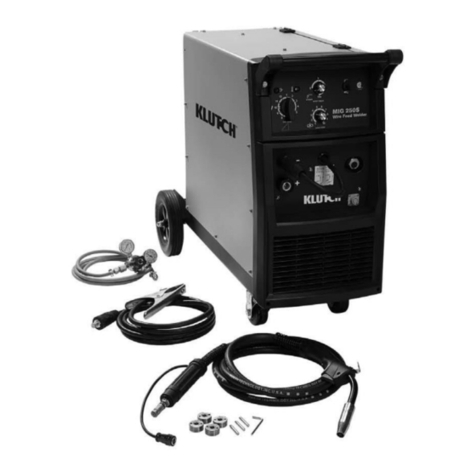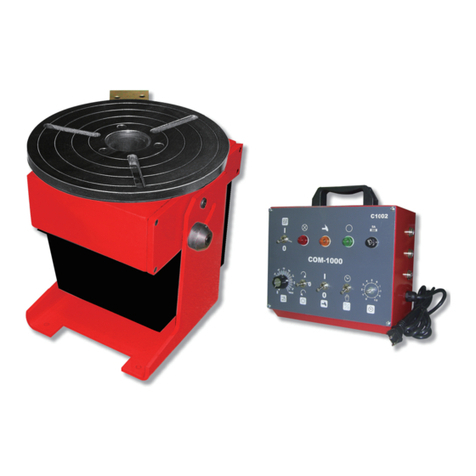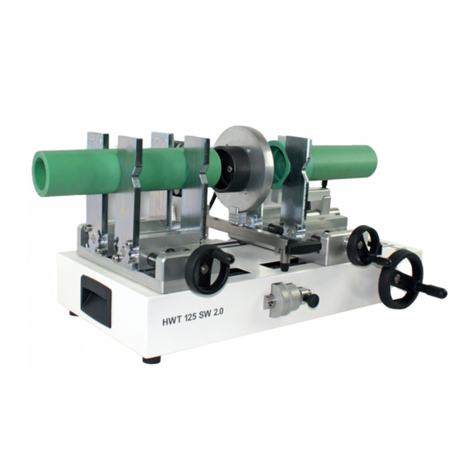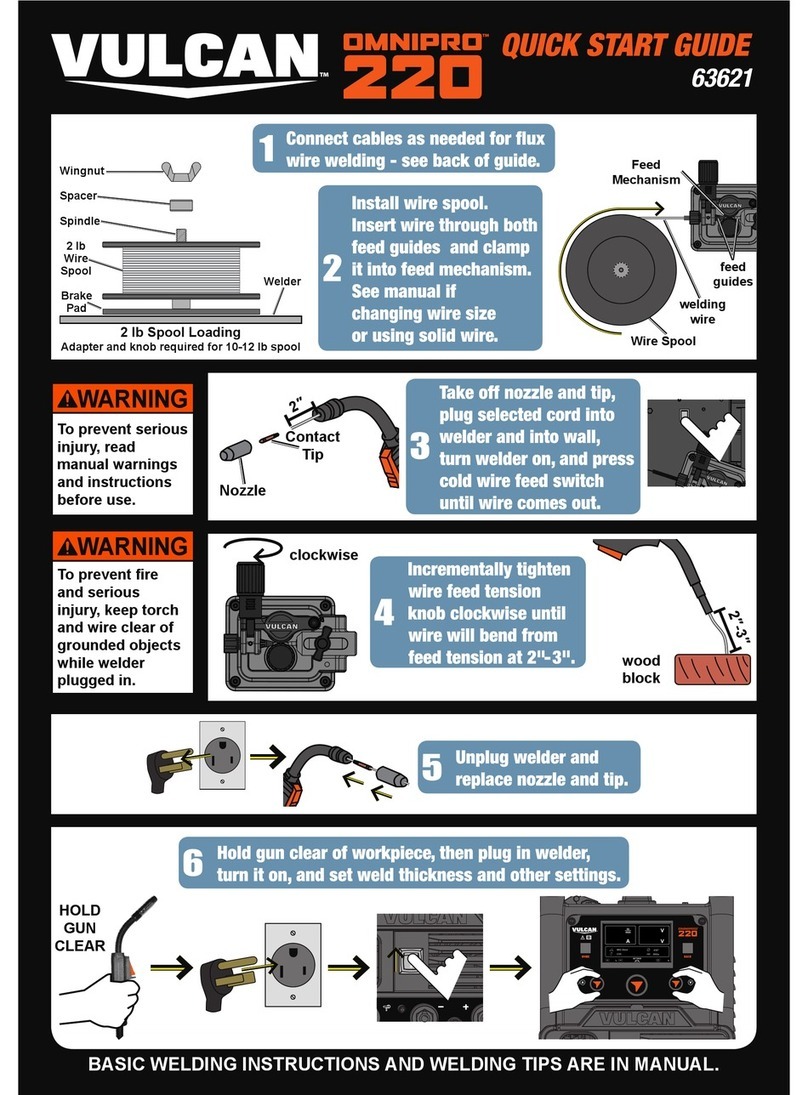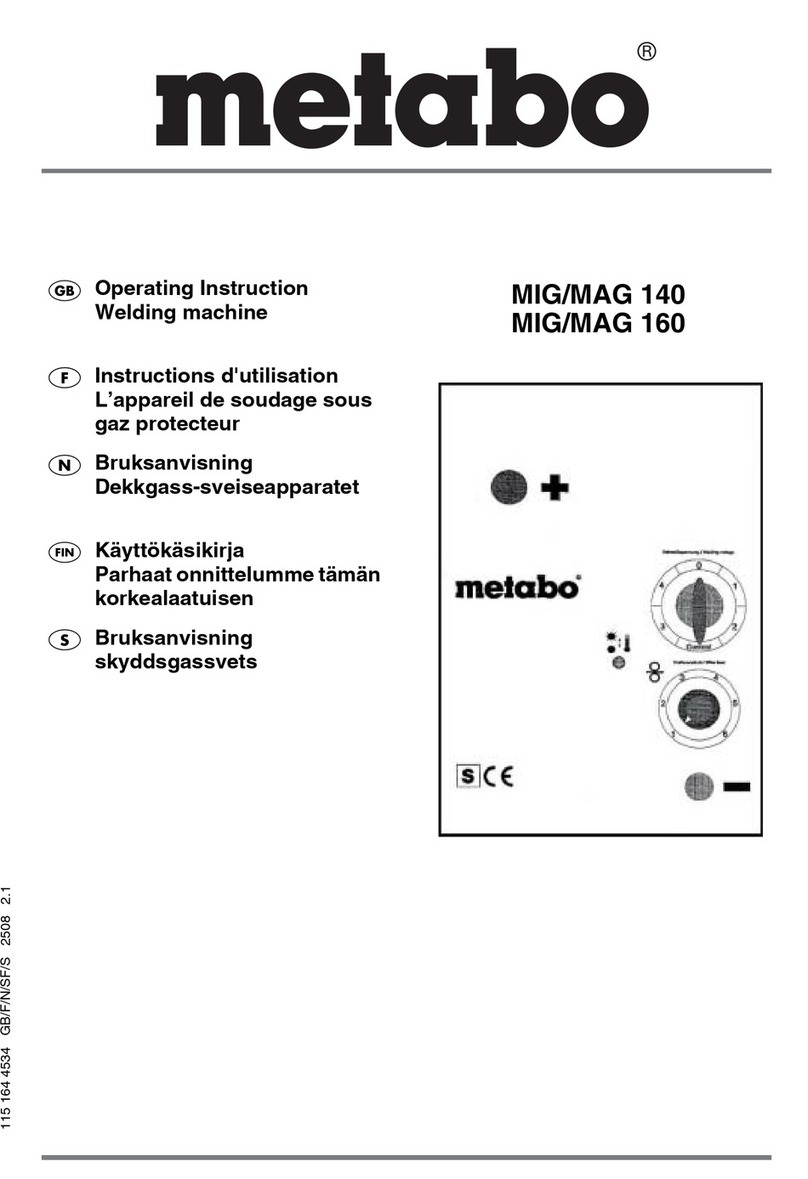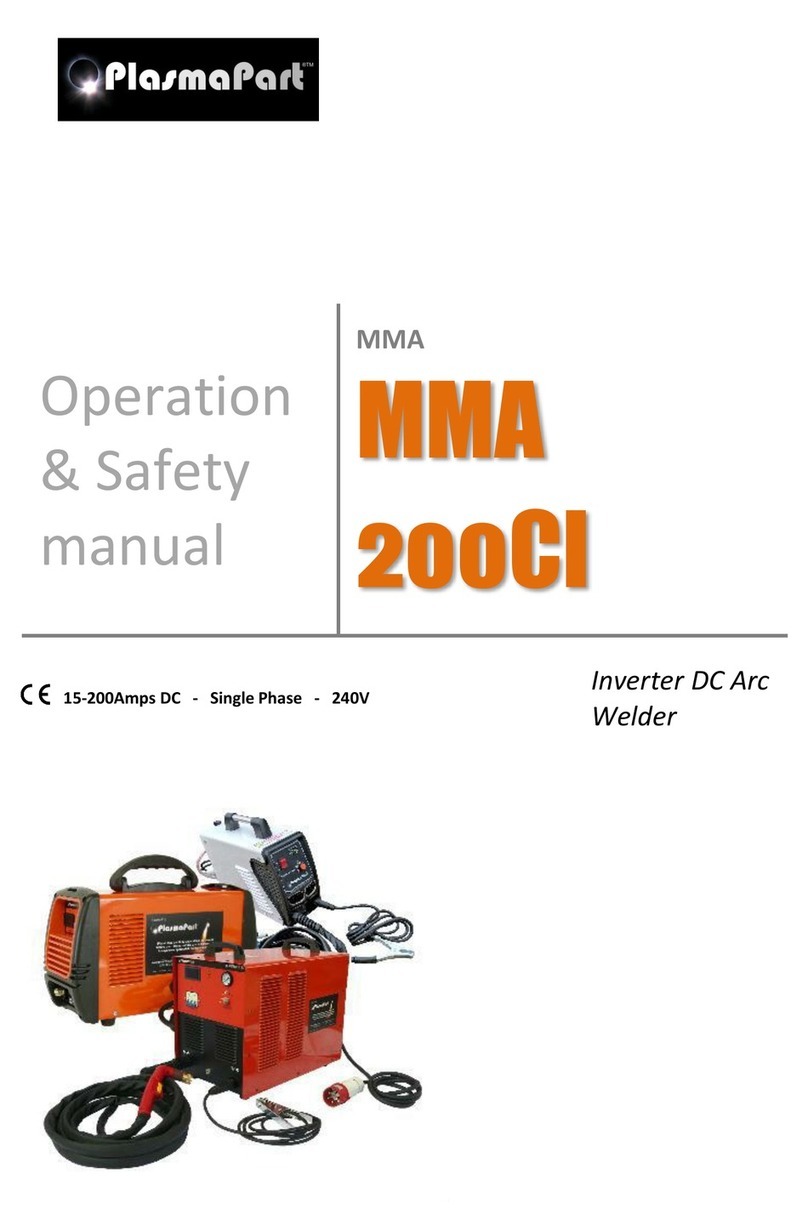Forney 140 MIG WELDER User manual

1WWW.FORNEYIND.COM
REV 04.12.17
CAT# 309
FEATURES:
• Welding range up to 140 Amps / 120V
Input
• Can be used for Mild Steel, Stainless Steel,
Aluminum and Cast Iron
• Large cabinet with easy access to spools
• Metallic heavy-duty wire drive system
• Torch/Cable wrap
• Premium MIG torch with Euro disconnect
and Tweco®style consumables
IDEAL FOR:
Do-It-Yourself, Agriculture, Maintenance
& Repair, Contractor, Automotive, Metal
Fabrication Hobbyist and More...
INCLUDES:
Welding Torch, Ground Clamp, Power Cable,
Gas Hose and Regulator
140 MIG WELDER
OPERATING MANUAL
ENGLISH

2WWW.FORNEYIND.COM
Forney Promise
We are committed to your success regardless of location, size or
needs. We understand it is your goal to get the job done right,
and we are ready to help you do just that.
President's Message
We market the highest quality tools, equipment and accessories
for the do-it-yourselfer and professional. Our passion and
dedication in bringing new products to the industrial and retail
market, combined with our personal service, is unmatched in our
industry. Our ability to listen to our customers’ needs enables us to
create solutions to their problems.
Our dedication to the highest quality customer service within our
corporate headquarters and the service provided in the field is
unequaled. We are committed to creating the best solutions to our
customer’s needs. Above all, our employees will provide the same
respect and caring attitude within the organization as they are
expected to share with every Forney customer. Our goal will be to
exceed our customers’ expectations through empowered people,
guided by shared values and commitments.
We work hard so our customers trust us because of our integrity,
teamwork and innovation of Forney products, and Forney’s
80 years of unmatched product quality and an unwavering
commitment to our customers.
When our customers succeed we succeed.
STEVEN G. ANDERSON, President & CEO
Copyright© 2014 Forney Industries,
Inc. All rights reserved. Unauthorized
reproduction and/or distribution is
subject to US copyright laws.
U.S. Warehouses:
- Fort Collins, CO
- Tipp City, OH
FIVE WAYS TO ORDER
Web: www.forneyind.com
Phone: 800-521-6038
Fax: 970-498-9505
Mail: Forney Industries
2057 Vermont Drive
Fort Collins, CO 80525
Email: sales@forneyind.com

3
WWW.FORNEYIND.COM
STOP!
PLEASE DO NOT
RETURN TO THE STORE
If you have questions or problems with your new plasma cutter,
please call customer service at 1-800-521-6038
Monday through Friday from 7 a.m. - 5 p.m. (MST) or at
www.forneyind.com/about-us/contact-us.
Please take time to register your product at
www.forneyind.com/support/product-registration.
Thank you and enjoy your new welder.
For the most up-to-date
warranty information,
visit www.forneyind.com

4WWW.FORNEYIND.COM
CAUTION!
BEFORE INSTALLING, OPERATING OR CARRYING OUT MAINTENANCE ON THE MACHINE, READ THE CONTENTS OF THIS MANUAL
CAREFULLY, PAYING PARTICULAR ATTENTION TO THE SAFETY RULES AND HAZARDS.
In the event of these instructions not being clear, please contact your
Forney Authorized Dealer or Forney Customer Service 1-800-521-6038
• Safety in Welding and Cutting, ANSI Standard Z49.1, from American Welding Society, 8669 Doral
Boulevard, Suite 130, Doral, FL 33166 Safety and Health Standards, OSHA 29 CFR 1910, from
Superintendent of Documents, U.S. Government Printing Office, Washington, D.C. 20402.
• Recommended Safe Practices for the Preparation for Welding and Cutting of Containers That Have
Held Hazardous Substances, American Welding Society Standard AWS F4.1, from American
Welding Society, 8669 Doral Boulevard, Suite 130, Doral, FL 33166
• National Electrical Code, NFPA Standard 70, from National Fire Protection Association,
Batterymarch Park, Quincy, MA 02269.
• Safe Handling of Compressed Gases in Cylinders, CGA Pamphlet P-1, from Compressed Gas
Association, 1235 Jefferson Davis Highway, Suite 501, Arlington, VA 22202.
• Code for Safety in Welding and Cutting, CSA Standard W117.2, from Canadian Standards
Association, Standards Sales, 178 Rexdale Boulevard, Rexdale, Ontario, Canada M9W 1R3.
• Safe Practices For Occupation And Educational Eye And Face Protection, ANSI Standard Z87.1,
from American National Standards Institute, 1430 Broadway, New York, NY 10018.
• Cutting And Welding Processes, NFPA Standard 51B, from National Fire Protection Association,
Batterymarch Park, Quincy, MA 02269
California Proposition 65 Warning
WARNING: This product can expose you to chemicals including lead, which are known to the State of California to
cause cancer and birth defects or other reproductive harm. For more information go to www.P65Warnings.ca.gov. P65
details at forneyind.com. Wash hands after use.
EMF Information
Welding or cutting current, as it flows through the welding or cutting cables, will cause electromagnetic
fields. There has been and still is some concern about such fields. However, after examination the
committee of the National Research Council concluded that: “The body of evidence, in the committee’s
judgment, has not demonstrated that exposure to power-frequency electric and a magnetic field is a
human health hazard.” However, studies are still going forth and evidence continues to be examined.
Until the final conclusions of the research are reached, you may wish to minimize your exposure to
electromagnetic fields when welding or cutting.
To reduce magnetic fields in the workplace, use the following procedures:
1. Keep cables close together by twisting or taping them.
2. Arrange cables to one side and away from the operator.
3. Do not coil or drape cables around your body.
4. Keep welding or cutting power source and cables as far away from operator as practical.
5. Connect work clamp to work piece as close to the cut or weld as possible.
ABOUT PACEMAKERS & HEARING AIDS:
Pacemaker & Hearing Aid wearers consult your doctor first. If cleared by your doctor, then following
the above procedures is recommended.
Safety Information
Principal Safety Standards

5
WWW.FORNEYIND.COM
Personal Protection
Welding processes of any kind can be dangerous not only to the operator but to any person situated
near the equipment, if safety and operating rules are not strictly observed.
THE WELDING ARC PRODUCES VERY BRIGHT ULTRAVIOLET AND INFRARED
LIGHT. THESE ARC RAYS WILL DAMAGE YOUR EYES AND BURN YOUR SKIN IF
YOU ARE NOT PROPERLY PROTECTED. To reduce the risk of injury from arc rays, read,
understand, and follow the safety instructions. In addition, make certain that anyone else that
uses this welding equipment, or is a bystander in the welding area understands and follows
these safety instructions as well. Helmets and filter should conform to ANSI Z87.1 standards.
• Do not look at an electric arc without proper protection. A welding arc is extremely bright
and intense and, with inadequate or no eye protection, the retina can be burned, leaving
a permanent dark spot in the field of vision. A shield or helmet with a #10 shade filter lens
(minimum) must be used.
• Do not strike a welding arc until all bystanders and you (the welder) have welding shields
and/or helmets in place.
• Do not wear a cracked or broken helmet and replace any cracked or broken filter lenses
immediately.
• Do not allow the uninsulated portion of the wire feed gun to touch the ground clamp or
grounded work to prevent an arc flash from being created on contact.
• Provide bystanders with shields or helmets fitted with an appropriate shade filter lens.
• Wear protective clothing. The intense light of the welding arc can burn the skin in much
the same way as the sun, even through light-weight clothing. Wear dark clothing of heavy
material. The shirt worn should be long sleeved and the collar kept buttoned to protect chest
and neck.
• Protect against reflected arc rays. Arc rays can be reflected off shiny surfaces such as a glossy
painted surface, aluminum, stainless steel, and glass. It is possible for your eyes to be injured
by reflected arc rays even when wearing a protective helmet or shield. If welding with a
reflective surface behind you, arc rays can bounce off the surface and off the filter lens. It can
get inside your helmet or shield and into your eyes. If a reflective background exists in your
welding area, either remove it or cover it with something non-flammable and non-reflective.
Reflective arc rays can also cause skin burn in addition to eye injury.
• Flying sparks can injure. Wear proper safety equipment to protect eyes and face. Shape
tungsten electrode on grinder wearing proper protection and in a safe location. Keep
flammables away and prevent fire from flying sparks.
FUMES, GASSES, AND VAPORS CAN CAUSE DISCOMFORT, ILLNESS, AND
DEATH! To reduce the risk, read, understand, and follow the safety instructions. In addition,
make certain that anyone else that uses this welding equipment or is a bystander in the welding
area, understands and follows these safety instructions as well.
• Read and understand manufacturers SDS and MSDS.
• Do not weld in an area until it is checked for adequate ventilation as described in ANSI
standard Z49.1. If ventilation is not adequate to exchange all fumes and gasses generated
during the welding process with fresh air, do not weld unless you (the welder) and all
bystanders are wearing air-supplied respirators.
• Do not heat metals coated with, or that contain, materials that produce toxic fumes (such as
galvanized steel), unless the coating is removed. Make certain the area is well ventilated, and
the operator and all bystanders are wearing air-sup plied respirators.
• Do not weld, cut or heat lead, zinc, cadmium, mercury, beryllium, antimony, cobalt,
manganese, selenium, arsenic, copper, silver, barium, chromium, vanadium, nickel, or similar
metals without seeking professional advice and inspection of the ventilation of the welding

6WWW.FORNEYIND.COM
area. These metals produce extremely toxic fumes which can cause discomfort, illness and
death.
• Do not weld or cut in areas that are near chlorinated solvents. Vapors from chlorinated
hydrocarbons, such as trichloroethylene and perchloroethylene, can be decomposed by the
heat of an electric arc or its ultraviolet radiation. These actions can cause phosgene, a highly
toxic gas, to form, along with other lung and eye-irritating gasses. Do not weld or cut where
these solvent vapors can be drawn into the work area or where the ultraviolet radiation can
penetrate to areas containing even very small amounts of these vapors.
• Do not weld in a confined area unless it is being ventilated or the operator (and anyone else
in the area) is wearing an air-supplied respirator.
• Stop welding if you develop momentary eye, nose, or throat irritation as this indicates
inadequate ventilation. Stop work and take necessary steps to improve ventilation in the
welding area. Do not resume welding if physical discomfort persists.
Fire Prevention
FIRE OR EXPLOSION CAN CAUSE DEATH, INJURY, AND PROPERTY DAMAGE!
To reduce these risks, read, understand and follow the safety instructions. In addition, make
certain that anyone else that uses this welding equipment, or is a bystander in the welding
area, understands and follows these safety instructions as well. Remember: arc welding by
nature produces sparks, hot spatter, molten metal drops, hot slag and hot metal parts that can
start fires, burn skin and damage eyes.
• Do not wear gloves or other clothing that contains oil, grease, or other flammable
substances.
• Do not wear flammable hair preparations.
• Do not touch the hot weld bead or weld puddle until fully cooled.
• Do not weld in an area until it is checked and cleared of combustible and/or flammable
materials. Be aware that sparks and slag can fly 35 feet and can pass through small cracks
and openings. If work and combustibles cannot be separated by a minimum of 35 feet,
protect against ignition with suitable, snug-fitting, fire resistant, covers or shields.
• Do not weld on walls until checking for and removing combustibles touching the other side of
the walls.
• Do not weld, cut, or perform other such work on used barrels, drums, tanks, or other
containers that had a flammable or toxic substance. The techniques for removing flammable
substance and vapors, to make a used container safe for welding or cutting, are quite
complex and require special education and training.
• Do not strike an arc on a compressed gas or air cylinder. Doing so will create a brittle
area that can result in a violent rupture immediately or at a later time as a result of rough
handling.
• Do not weld or cut in an area where the air may contain flammable dust (such as grain
dust), gas, or liquid vapors (such as gasoline).
• Do not handle hot metal, such as the work piece or electrode stubs, with bare hands.
• Wear leather gloves, heavy long sleeve shirt, cuffless pants, high-topped shoes, helmet, and
cap. As necessary, use additional protective clothing such as leather jacket or sleeves, fire
resistant leggings, or apron. Hot sparks or metal can lodge in rolled up sleeves, pant cuffs,
or pockets. Sleeves and collars should be kept buttoned and pockets eliminated from the shirt
front.
• Have fire extinguisher equipment handy for immediate use. A portable chemical fire
extinguisher, type ABC, is recommended.
• Wear ear plugs when welding overhead to prevent spatter or slag from falling into ear.
• Make sure welding area has a good, solid, safe floor, preferably concrete or masonry, not
tiled, carpeted, or made of any other flammable material.
• Protect flammable walls, ceilings, and floors with heat resistant covers or shields.

7
WWW.FORNEYIND.COM
• Check welding area to make sure it is free of sparks, glowing metal or slag, and flames
before leaving the welding area.
• Wear garments free of oil or other flammable substances such as leather gloves, thick cotton
shirts with no synthetic materials, cuffless trousers, closed toed shoes. Keep long hair pulled
back.
• Remove any combustibles such as lighters and matches before doing any welding.
• Follow requirements in OSHA and NFPA for hot work and have an extinguisher nearby.
High Frequency Radiation
• High Frequency (H.F) can interfere with radio navigation, safety services, computers and
communication equipment.
• It is the user’s responsibility to have a qualified electrician promptly correct any interference
problem resulting from the installation. Electrician should regularly check and maintain
installation.
• Stop using the equipment if notified by the FCC about interference.
• Keep H.F. source doors and panels tightly shut and keep spark gaps at correct setting.
Arc Welding
• Computers and computer driven equipment can be harmed with electromagnetic energy.
• Be sure all equipment is compatible with electromagnetic energy.
• Keep welding cables short to reduce interference.
• Follow manual to install and ground machine.
• If interference continues, shield the work area or move the welding machine.
WARNING: ELECTRIC SHOCK CAN KILL! To reduce the risk of death or serious injury
from shock, read, understand, and follow the safety instructions. In addition, make certain
that anyone else who uses this welding equipment, or who is a bystander in the welding area
understands and follows these safety instructions as well.
IMPORTANT! TO REDUCE THE RISK OF DEATH, INJURY, OR PROPERTY
DAMAGE, DO NOT ATTEMPT OPERATION of this welding equipment until you have read
and understand the following safety summary.
• Do not, in any manner, come into physical contact with any part of the welding current
circuit. The welding current circuit includes:
a. the work piece or any conductive material in contact with it,
b. the ground clamp,
c. the electrode or welding wire,
d. any metal parts on the electrode holder, or wire feed gun.
• Do not weld in a damp area or come in contact with a moist or wet surface.
• Do not attempt to weld if any part of clothing or body is wet.
• Do not allow the welding equipment to come in contact with water or moisture.
• Do not drag welding cables, wire feed gun, or welder power cord through or allow them to
come into contact with water or moisture.
• Do not touch welder, attempt to turn welder on or off if any part of the body or clothing is
moist or if you are in physical contact with water or moisture.
• Do not attempt to plug the welder into the power source if any part of body or clothing is
moist, or if you are in physical contact with water or moisture.
• Do not connect welder work piece clamp to or weld on electrical conduit.
Electric Shock

8WWW.FORNEYIND.COM
• Do not alter power cord or power cord plug in any way.
• Do not attempt to plug the welder into the power source if the ground prong on power cord
plug is bent over, broken off, or missing.
• Do not allow the welder to be connected to the power source or attempt to weld if the welder,
welding cables, welding site, or welder power cord are exposed to any form of atmospheric
precipitation, or salt water spray.
• Do not carry coiled welding cables around shoulders, or any other part of the body, when
they are plugged into the welder.
• Do not modify any wiring, ground connections, switches, or fuses in this welding equipment.
• Wear welding gloves to help insulate hands from welding circuit.
• Keep all liquid containers far enough away from the welder and work area so that if spilled,
the liquid cannot possibly come in contact with any part of the welder or electrical welding
circuit.
• Replace any cracked or damaged parts that are insulated or act as insulators such as
welding cables, power cord, or electrode holder immediately.
• When not welding, cut wire back to contact tip or remove electrode from electrode holder.
Noise
Noise can cause permanent hearing loss. Welding processes can cause noise levels that exceed
safe limits. You must protect your ears from loud noise to prevent permanent loss of hearing.
• To protect your hearing from loud noise, wear protective ear plugs and/or ear muffs.
• Noise levels should be measured to be sure the decibels (sound) do not exceed safe levels.
Additional Safety Information
For additional information concerning welding safety, refer to the following standards and comply with
them as applicable.
• ANSI Standard Z49.1 - SAFETY IN WELDING AND CUTTING - obtainable from the
American Welding Society, 550 NW Le Jeune Road, Miami, FL 33126 Telephone (800)
443-9353, Fax (305) 443-7559 - www.amweld.org or www.aws.org
• ANSI Standard Z87.1 - SAFE PRACTICE FOR OCCUPATION AND EDUCATIONAL EYE
AND FACE PROTECTION - obtainable from the American National Standards Institute, 11
West 42nd St., New York, NY 10036 Telephone (212) 642A900, Fax (212) 398-0023 -
www.ansi.org
• NFPA Standard 518 - CUTTING AND WELDING PROCESS - obtainable from the National
Fire Protection Association, 1 Batterymarch Park, P.O. Box 9101, Quincy, MA 02269-9101
Telephone (617) 770-3000 Fax (617) 770-0700 - www.nfpa.org
• OSHA Standard 29 CFR, Part 1910, Subpart Q., WELDING, CUTTING AND BRAZING
- obtainable from your state OSHA office or U.S. Dept. of Labor OSHA, Office of Public
Affairs, Room N3647, 200 Constitution Ave., Washington, DC 20210 - www.osha.gov
• CSA Standard W117.2 - Code for SAFE TY IN WELDING AND CUTTING. - obtainable
from Canadian Standards Association, 178 Rexdale Blvd., Etobicoke, Ontario M9W 1R3 -
www.csa.ca
• American Welding Society Standard A6.0. WELDING AND CUTTING CONTAINERS
WHICH HAVE HELD COMBUSTIBLES. - obtainable from the American Welding Society, 550
NW Le Jeune Road, Miami, FL 33126 Telephone (800) 443-9353, Fax (305) 443-7559 -
www.amweld.org or www.aws.org

9
WWW.FORNEYIND.COM
WARRANTY................................................................................................................................................3
SAFETY SUMMARY .....................................................................................................................................4
PRINCIPAL SAFETY STANDARDS ............................................................................................................4
CALIFORNIA PROPOSITION 65 WARNING............................................................................................4
EMF INFORMATION..............................................................................................................................4
PERSONAL PROTECTION ......................................................................................................................5
FIRE PREVENTION.................................................................................................................................6
HIGH FREQUENCY RADIATION.............................................................................................................7
ARC WELDING.....................................................................................................................................7
ELECTRIC SHOCK..................................................................................................................................7
NOISE..................................................................................................................................................8
ADDITIONAL SAFETY INFORMATION....................................................................................................8
TABLE OF CONTENTS..................................................................................................................................9
INSTALLATION..........................................................................................................................................10
WELDER SPECIFICATIONS ..................................................................................................................10
SITE SELECTION .................................................................................................................................10
POWER SOURCE CONNECTION ........................................................................................................10
VENTILATION .....................................................................................................................................10
ADDITIONAL WARNINGS...................................................................................................................11
ASSEMBLY................................................................................................................................................11
TORCH CONNECTION .......................................................................................................................11
GAS CYLINDER AND REGULATOR CONNECTION ...............................................................................11
SHIELDING GAS GUIDE ......................................................................................................................12
WIRE LOADING..................................................................................................................................12
REPLACING THE WIRE LINER...............................................................................................................13
HOW TO CHOOSE THE WIRE LINER FOR DIRECT AND EURO CONNECT TORCHES .............................13
FLUXCORE WIRE WELDING (FCAW)....................................................................................................13
MIG WELDING (GMAW).....................................................................................................................13
MIG WELDING (GMAW) WELDING SETTING CHART ...........................................................................14
OPERATION..............................................................................................................................................15
DESCRIPTION .....................................................................................................................................15
WELDER CONTROLS...........................................................................................................................15
THERMAL OVERLOAD PROTECTION....................................................................................................15
TECHNICAL DATA INFORMATION GUIDE ............................................................................................16
WELDING PREPARATION ....................................................................................................................16
FACTORS TO CONSIDER FOR BEST WELDING RESULTS .......................................................................16
ALUMINUM WELDING........................................................................................................................17
MAINTENANCE & SERVICING...................................................................................................................17
GENERAL MAINTENANCE..................................................................................................................17
TROUBLSHOOTING...................................................................................................................................18
WIRING DIAGRAM ...................................................................................................................................20
TOOLS AND SPARE PARTS LIST..................................................................................................................21
PARTS DIAGRAM ......................................................................................................................................22
MIG GUN TORCH SPARE PARTS LIST..........................................................................................................23
USER NOTES ............................................................................................................................................24
Table of Contents

10 WWW.FORNEYIND.COM
Table 1. Welder Specifications
Primary (input) volts 120 VAC
Welding Output 140A maximum
Phase Single
Frequency
Rated Duty Cycle 60Hz
20%
Wire Diameter Range: Up to 0.030”
BE SURE TO LOCATE THE WELDER ACCORDING TO THE FOLLOWING GUIDELINES:
• In areas free from moisture and dust;
• In areas with ambient temperature between 30° to 90°F;
• In areas free from oil, steam and corrosive gases;
• In areas not subjected to abnormal vibration or shock;
• In areas not exposed to direct sunlight or rain;
• Place at a distance of 12” or more from walls or similar obstructions that could restrict
natural air flow for cooling.
Before you make any electrical connection, make sure that supply voltage and frequency available at
site are those stated in the ratings label of your welder.
The main supply voltage should be within ±10% of the rated main supply voltage. Too low a voltage
may cause poor welding performance. Too high a supply voltage will cause components to overheat
and possibly fail. The welder outlet must be:
• Correctly installed, if necessary, by a qualified electrician;
• Correctly grounded (electrically) in accordance with local regulations;
• Connected to the correct size electric circuit.
NOTE:
• Periodically inspect supply cable for any cracks or exposed wires. If it is not in good
condition, have it repaired by a Service Center.
• Do not violently pull the input power cable to disconnect it from supply outlet.
• Do not lay material or tools on the power supply cable. The cable may be damaged and
result in electrical shock.
• Keep the supply cable away from heat sources, oils, solvents or sharp edges.
• If you use an extension cord, keep it as straight as possible. Use 10 AWG.
Since the inhalation of welding fumes can be harmful, ensure that the welding area is
effectively ventilated.
Installation
Welder Specifications
Site Selection
Power Source Connection
Ventilation

11
WWW.FORNEYIND.COM
FOR YOUR SAFETY, BEFORE CONNECTING THE POWER SOURCE TO THE LINE
CLOSELY FOLLOW THESE INSTRUCTIONS:
• An adequate two-pole switch must be inserted before the main outlet. This switch must be
equipped with time-delay fuses.
• The ground connection must be made with a two-pole plug compatible with the above
mentioned socket.
• When working in a confined space, the welder must be kept outside the welding area and
the ground cable should be fixed to the workpiece. Never work in a damp or wet confined
space.
• Do not use damaged input or welding cables.
• The welding torch should never be pointed at the operator or other people.
• The welder must never be operated without its panels attached. This could cause serious
injury to the operator and could damage the equipment.
Connect the standard MIG torch to the threaded connector on the front of the welder and tighten firmly
by hand.
Gas Cylinder and Regulator Connection
The gas cylinder (not supplied) should be located at the rear of the welder, in a well-ventilated area
and securely fixed to the work bench or to the wall to ensure that it will not fall.
For safety and economy, ensure that the regulator is fully closed (turned counter-clockwise)
when not welding and when fitting or removing the gas cylinder.
• Turn the regulator adjustment knob counter-clockwise to ensure the valve is fully closed.
• Screw the gas regulator down on the gas bottle valve and tighten.
• Connect the gas hose to the regulator, securing with the clip/nut provided.
• Open the cylinder valve, then set the gas flow to approximately 20 - 35 CFH (cubic ft. per
hour) on the regulator.
• Operate the torch trigger to ensure that the gas is flowing through the torch.
WARNING: Cylinders are highly pressurized. Handle with care. Serious accidents can result
from improper handling or misuse of compresses gas cylinders. Do not drop the cylinder, knock
it over, expose it to excessive heat, flames or sparks. Do not strike it against other cylinders.
Additional Warnings
Assembly
Torch Connection

12 WWW.FORNEYIND.COM
Shielding Gas Guide
METAL GAS NOTE
Mild Steel CO2
Argon + CO2
Argon + CO2 + Oxygen Argon controls spatter
Oxygen improves arc stability
Aluminum Argon
Argon + Helium
Arc stability, good fusion and minimum splatter.
Higher heat input suitable for heavy sections.
Minimum porosity.
Stainless Steel Argon + CO2 + Oxygen
Argon + Oxygen Arc stability.
Minimum splatter.
Copper, Nickel & Alloys Argon
Argon + Helium
Suitable for light gauges because of low
flowability of the weld pool.
Higher heat input suitable for heavy sections.
Wire Loading
ENSURE THE GAS AND ELECTRICAL SUPPLIES ARE DISCONNECTED. BEFORE
PROCEEDING, REMOVE THE NOZZLE AND THE CONTACT TIP FROM THE
TORCH.
• Open the side panel.
• Loosen the nut of the spool holder (brake drum)
and remove the spring and the external ring. (Fig.4)
• Remove the plastic protection from the spool (4) and
place the wire spool on the spool holder.
• Mount the external ring, the spring and the
plastic lock nut again. These parts form the braking
system of the wire spool speed. NOTE: Do not
tighten the nut too much. Excessive pressure strains
the wire feeding motor, while too little pressure does
not allow the immediate stop of the wire spool at the
end of the welding.
• Loosen and lower the plastic knob (A) (Fig.5). Open
the pressure arm (B) of the feeder
• Disconnect the wire from the edge of the wire spool
being careful to keep tension on the end of the wire.
Cut off a short section of the end of the wire to insure
a straight end. Insert the straight end into the wire inlet
guide (C) past the wire feed roll and into the wire liner.
Lower pressure arm (B) and lift pressure adjustment
knob (A) into place. Connect the input power cord and
turn on the welder. Press the torch trigger and observe
the wire feeding into the torch liner. Adjust the pressure on the wire with knob (A) to insure
smooth feeding without slippage. Do not over-tighten the pressure adjustment as it may
damage the motor. Close the welder side panel. Remove the nozzle and contact tip from the
welding torch. Straighten the torch cable to remove any coils or kinks. Squeeze and hold
the torch trigger until the wire appears at the end of the torch neck. Turn off the welder and
install the contact tip and nozzle.

13
WWW.FORNEYIND.COM
WARNING: Keep the torch straight. When feeding a new wire through the liner, make sure
the wire is cut cleanly (no burrs or angles) and that at least 1” from the end is straight (no
curves). Failure to follow these instructions could cause damage to the liner.
WARNING: When changing the wire diameter being used, or replacing the wire feed roll,
be sure that the correct groove for the wire diameter selected is inside, closest to the machine.
The wire is driven by the inside groove. Feed rolls are marked on the side identifying the groove
nearest that side.
WARNING: To avoid injury, when loading wire and watching for it to come through the torch
neck do not hold the torch close to your face. Instead, direct it towards the floor. Do not place
fingers near the wire feed rolls when the wire feeder is operating.
Replacing the Wire Liner
ENSURE THE GAS AND ELECTRICAL SUPPLIES ARE DISCONNECTED.
• Disconnect the torch from the machine.
• Place it on a flat surface and carefully remove the brass nut (Fig. 6) (1).
• Pull the liner out of the hose.
• Install the new liner and mount the brass nut (Fig. 6)
(1) again. In case you are replacing a Teflon wire
liner, follow these instructions:
• Install the new liner followed by the collet (3).
• Insert the O ring (4) on the wire liner collet (4)and
replace the brass nut (1).
• Cut the wire liner close to the brass nut. NOTE: The
length of the new wire liner must be the same as the
liner you have just pulled out of the hose.
• Connect the torch to the machine and install the wire
into the feeding system.
How to Choose the Wire Liner for Direct and Euro Connect Torches
There are basically two types of wire liners: Steel and Teflon. Steel wire liners can be coated or non-
coated. Coated wire liners are used for air-cooled torches. Teflon wire liners are recommended for
aluminum welding as they allow smooth feeding of the wire.
FluxCore Wire Welding (FCAW)
• Connect the ground cable to the positive terminal of the
Polarity Change Board inside the spool compartment.
• Connect the working cable to the negative terminal of
Polarity Change Board inside the spool compartment.
MIG Welding (GMAW)
• Connect the ground cable to the negative terminal on the
Polarity Change Board inside the spool compartment.
• Connect the working cable to the positive terminal of the
Polarity Change Board inside the spool compartment.

14 WWW.FORNEYIND.COM
MIG Welding (GMAW) Welding Setting Chart
Regulation Knob
Voltage
Setting Wire Feed
Setting Voltage
Setting Wire Feed
Setting Voltage
Setting Wire Feed
Setting Voltage
Setting Wire Feed
Setting Voltage
Setting Wire Feed
Setting Voltage
Setting Wire Feed
Setting Voltage
Setting Wire Feed
Setting
Mild Steel
Solid Wire
75% A + 25%
CO2 (ER70S-6)
.023” (0.6 mm) 1 3 1 3 2 7.5 2 7.5 3 8.5 4 9 - -
.030” (0.8 mm) 1 2 1 2 1 3.5 2 5.5 3 7 4 8 4 8
.035” (0.9 mm) - - - - 2 3 2 4 3 6 4 8 4 8
Flux Core Wire
(No Gas)
(E71T-GS)
.030” (0.8 mm) 1 2 1 2 1 3 2 5 4 8 4 9 4 9
.035” (0.9 mm) - - - - 1 2 2 4 4 8 4 8.5 4 8.5
Stainless Steel
Solid Wire
98% Ar
2% CO2
.023” (0.6 mm) 1 3 1 3 1 3.5 2 6 3 8.5 4 9 - -
.030” (0.8 mm) - - 1 2 1 3.5 2 4 3 7 4 8 4 8
.035” (0.9 mm) - - - - 1 3 1 3.5 3 7 4 7.5 4 7.5
MATERIAL
(Wire) GAS WIRE ø
MATERIAL THICKNESS
24 Gauge
.0236” (.6 mm) 22 Gauge
.0315” (.8 mm) 20 Gauge
.0354” (.9 mm) 18 Gauge
.0236” (1.2 mm) 1/8” (3 mm) 3/16” (4.5 mm) 1/4” (6.4 mm)
140 MIG SET-UP CHART
Arc Voltage Control Wire Speed Control
This control sets the
arc welding voltage. It
is proportional to the
amount of heat in the arc.
Position 6 is the highest
arc voltage or heat setting.
wire Feed
This sets the wire feed
speed (WFS) of the
electrode wire through
the MIG gun.
Position 0 is 80 IPM
Position 10 is 700 IPM
Forney Industries, Inc.
www.forneyind.com
1
2
3
4
Pressure Adjust Device
POLARITY
CHANGE
+/-
Pressure Arm
Gun Cable End
Wire Spool Inlet Wire Guide Feedroll
Top-loading

15
WWW.FORNEYIND.COM
The Forney 140 MIG welder is designed for use on jobs involving maintenance and fabrication. It is
ideal for applications such as farming, automotive, and repairs. This transformer-based machine is
powered from standard 120V household current and produces 140 A output. The acceptable wire
diameters for use on this machine include .024” and .030”. The Forney 190 MIG and Forney 190 MP
are capable of accepting wire diameters up to .035”. The spool sizes compatible with this machine are
4” and 8” and should be loaded clockwise, so the wire feeds from the top into the wire feeing system.
This machine can weld materials up to ¼” thick.
Units may be used with the standard torch.
1. Main ON/OFF switch and welding voltage adjustment
2. Wire feed adjustment knob:
To increase the wire speed, turn the potentiometer
clockwise; to decrease the wire speed, turn
it counter-clockwise. The same procedure decreases the
values on the welding parameters. Turn
knob slowly.
3. Ground Clamp
4. MIG Torch/Gun
CAT# 309
120V MIG WIRE FEED WELDER
WELDING RANGE UP TO 140 AMPS
1
3
2
4
WARNING: If the duty cycle of the welder is exceeded, a thermostat will automatically cut
the power to prevent the machine from overheating. If this should happen do not unplug the
machine while it cools down. The thermostat will automatically reset itself and you can continue
welding. The thermostat is a protective safety device and no harm will normally be done to the
welder unless it is frequently over-loaded, in which case it may eventually become damaged.
Operation
Description
Welder Controls
Thermal Overload Protection

16 WWW.FORNEYIND.COM
1. Serial number of the unit
2. Welder model
3. Type of characteristic
4. Min. - Max rated No Load Voltage
5. Type of welding
6. Symbol for the main supply and no. of phases
7. Rated value of the supply voltage
8. Code letter for degree of insulation
9. Protection degree
10. Power
11. Size of the necessary main fuse
12. Supply current
13. Welding supply and voltage
14. Power Factor
15. Control range (current / voltage)
16. Reference standard
• Attach the ground clamp to the bare metal to be welded, making sure of good contact;
• Make sure that the wire-roller groove in the roller corresponds to the diameter of the wire
being used.
• Plug the machine into a suitable outlet.
•
Completely open the gas cylinder valve. Adjust the gas pressure regulator to the correct
flow rate.
Some experience is required to adjust and use a MIG welder. In MIG welding two parameters are
fundamental: the welding voltage and the wire speed. The resulting welding current is a result of these
two settings.
• Set the voltage and wire feed controls to positions suitable for the thickness of the material
to be welded. Welding current varies in relationship to wire feed speed. For low welding
current output, the wire feed speed potentiometer should be set at the low end of the wire
feed speed scale. Turning the wire feed speed control potentiometer clockwise will result
in increased wire feed speed and welding current. Welding voltage is adjusted to match
the wire feed speed (welding current). Progressively select higher voltage positions while
increasing wire speed.
Technical Data Information Guide
Welding Preparation
Factors to Consider for Best Welding Results

17
WWW.FORNEYIND.COM
Increasing welding voltage leads to a longer arc (without substantially affecting the current).
Conversely, a decreased welding voltage results in a shorter arc (the current again is not substancially
changed). A change in wire diameter results in changed parameters. A smaller diameter wire
requires an increase in wire feed speed to reach the same current. If certain limits are exceeded, a
satisfactory weld cannot be obtained. These are:
A) Feeding wire too fast (too high with regard to the welding voltage) results in pulsing within
the torch. This is because the wire electrode dips into the puddle and cannot be melted off fast
enough.
B) Setting welding voltage to high (too high with regard to the wire feed speed), will result in
excessive and unstable arc. Increase the voltage even higher and the contact tip will burn.
C) Excessive wire speed can be corrected through the arc voltage increase. The limit of this
adjustment depends on the thickness of the material to be welded (a certain limit exceeded
will result in burn through).
Place the torch on the joint you want to weld: the angle between the torch and the nozzle should be
around 45°. The distance between the torch and the work piece should be 5-1/2”. Lower the face
shield and press the torch trigger to start the arc. When the arc has struck, move the nozzle slowly
from left to right along the joint. Adjust the wire feed speed until the arc makes a “crisp” sound
(experience will help you to recognize the right sound).
The machine should be set up for mild steel except for the following changes:
• 100% ARGON as welding protective gas.
• Ensure that your torch is set up for aluminum welding:
• The length of the torch cable should not exceed 10’ (it is advisable not to use longer torches).
•
Install a Teflon wire liner. Follow the instructions for changing the renewing of the wire liner.
• Ensure that drive rolls are suitable for aluminum wire.
• Use contact tips that are suitable for aluminum wire and make sure that the diameter of the
contact tip hole corresponds to the wire diameter that is going to be used.
• Always weld clean, dry and well-prepared material.
• Hold gun at a 45° angle to the workpiece with nozzle about 1/2” from the surface.
• Move the gun smoothly and steadily as you weld.
• Avoid welding in very drafty areas. A weak, pitted and porous weld will result due to air
blowing away the protective welding gas.
• Keep wire and wire liner clean. Do not use rusty wire.
• Sharp bends or kinks in the welding cable should be avoided.
• Always try to avoid getting particles of metal inside the machine since they could cause short
circuits or other damage.
• If available, use compressed air to periodically clean the hose liner, especially when
changing wire spools.
CAUTION: Disconnect from power source when carrying out this operation.
• Using low pressure air (3/5 Bar=20-30 PSI), occasionally blow the dust from the inside of
the welder. This keeps the machine running cooler. NOTE: Do not blow air over the printed
circuit board and electronic components.
• The wire feed roller will eventually wear during normal use. With the correct tension the
pressure roller must feed the wire without slipping. If the pressure roller and the wire feed
Aluminum Welding
Maintenance & Servicing
General Maintenance

18 WWW.FORNEYIND.COM
roller make contact when the wire is in place between them, the wire feed roller must be
replaced.
• Check all cables periodically. They must be in good condition and not cracked.
This chart will assist you in resolving common problems you may encounter. These are not all the
possible solutions.
PROBLEM POSSIBLE CAUSE POSSIBLE SOLUTION
No “power” from welder. Input cable or plug malfunction.
Wrong size fuse.
Faulty on/off switch.
Check for proper input cable
connection.
Check fuse and replace as
necessary.
Replace on/off switch.
Fan operates normally, but
when gun trigger pulled,
there is no wire feed, weld
output or gas flow.
Faulty trigger gun.
Thermostat intervention.
Replace torch trigger.
Allow welder to cool. When the
pilot lamp/switch on the front panel
goes dark indicates the thermostat
has closed.
Feed motor operates but
wire will not feed. Faulty wire feeding motor (rare).
Insufficient feed roller pressure.
Burr on end of wire.
Liner blocked or damaged.
Replace wire feeding motor.
Increase roller pressure.
Re-cut wire square with no burr.
Clear with compressed air or
replace liner.
Lack of penetration. Voltage or wire feed speed too low.
Loose connection inside the
machine (rare).
Worn or wrong size contact tip.
Loose gun connection or faulty gun
assembly.
Wrong size wire.
Torch moved too fast.
Re-adjust the welding parameters.
Clear with compressed air and
tighten all connections.
Replace the contact tip.
Tighten or replace torch.
Use correct size welding wire.
Move the gun smoothly and not too
fast.
Wire is birdnesting at the
drive roller. Eccessive pressure on drive roller.
Gun liner worn or damaged.
Contact tip clogged or damaged.
Liner stretched or too long.
Adjust pressure on drive roller.
Replace wire liner.
Replace contact tip.
Cut wire liner at the right length.
Troubleshooting

19
WWW.FORNEYIND.COM
PROBLEM POSSIBLE CAUSE POSSIBLE SOLUTION
Wire burns back to
contact tip. Contact tip clogged or damaged.
Wire feed speed too slow.
Wrong size contact tip.
Bad connection from cable to
clamp.
Slag buildup inside nozzle or
nozzle is shorted.
Replace the contact tip.
Increase wire speed.
Use correct size contact tip.
Tighten clamp connection or
replace cable.
Clean or replace nozzle.
Workpiece clamp and/or
cable gets hot. Wire feed speed too fast. Decrease wire feed speed.
Gun nozzle arcs to work
surface. Nozzle clogged. Clean or replace nozzle
Wire pushes torch back
from the workpiece. Torch held too far from the
workpiece. Hold the torch at the right distance.
Poor quality welds. Insufficient gas at weld area.
Rusty, painted, oil or greasy
workpiece.
Rusty or dirty wire.
Poor gound contact.
Incorrect gas/wire combination
Check that the gas is not being
blown away by drafts and, if so,
move to more sheltered weld area.
If not check gas cylinder contents
gauge, regulator setting and
operation of gas valve.
Ensure workpiece is clean and dry.
Ensure wire is clean and dry.
Check gound clamp/workpiece
connection.
Check the manual for the correct
combination.
Weld deposit “stringy” and
incomplete. Torch moved over workpiece too
quickly.
Gas mixture incorrect.
Move the torch slower.
See shielding gas table.
Weld deposit too thick. Torch moved over workpiece too
slowly.
Welding voltage too low.
Move the torch faster.
Increase welding voltage.

20 WWW.FORNEYIND.COM
Wiring Diagram
Other manuals for 140 MIG WELDER
1
Table of contents
Languages:
Other Forney Welding System manuals
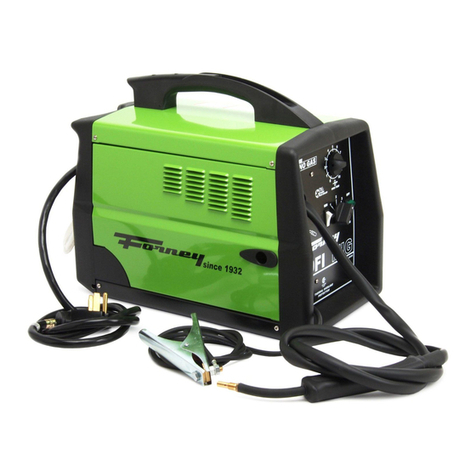
Forney
Forney MIG 180FI User manual
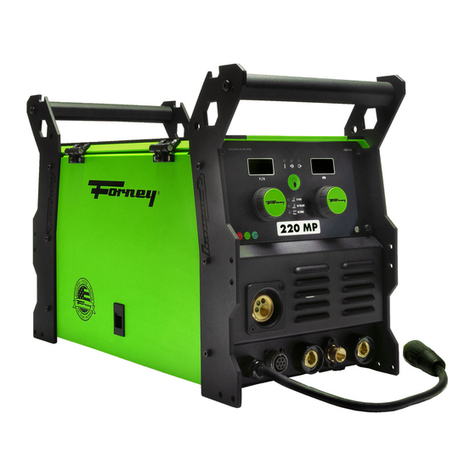
Forney
Forney 220 MP User manual
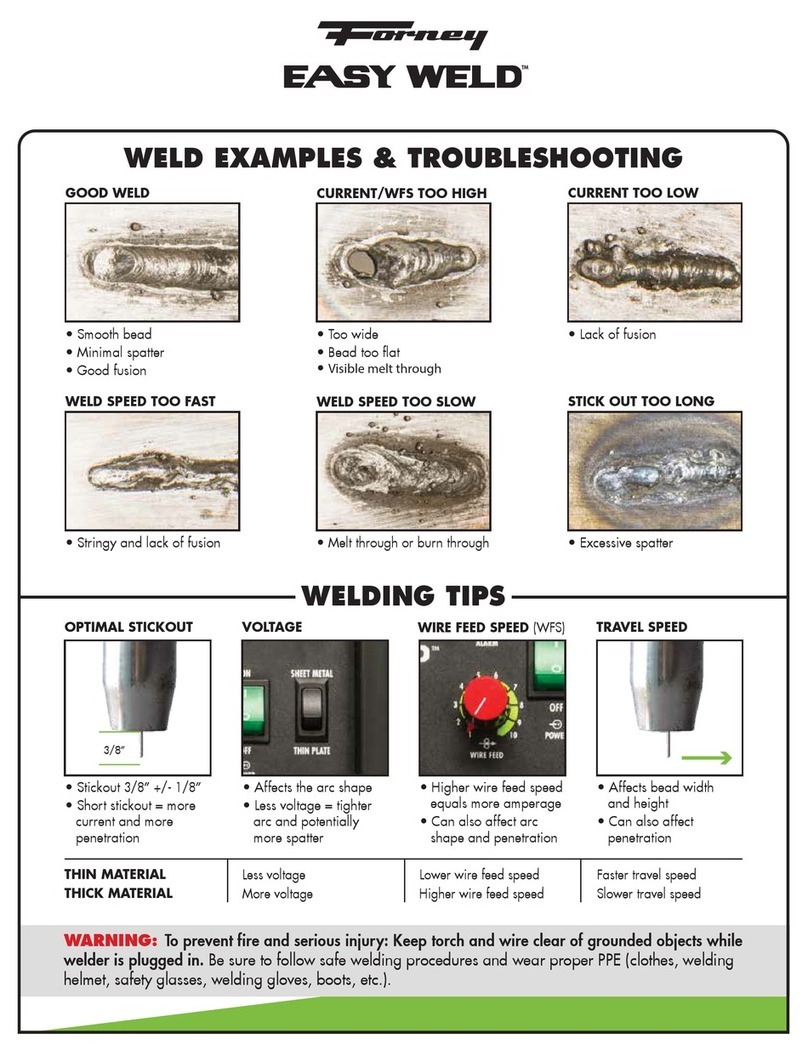
Forney
Forney Easy Weld series User manual
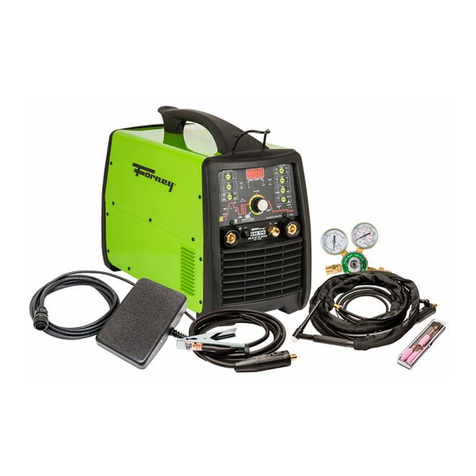
Forney
Forney 220 TIG AC/DC User manual
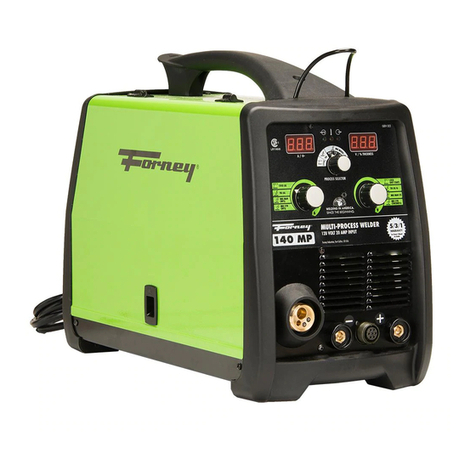
Forney
Forney 140 MP User manual

Forney
Forney 190 User manual
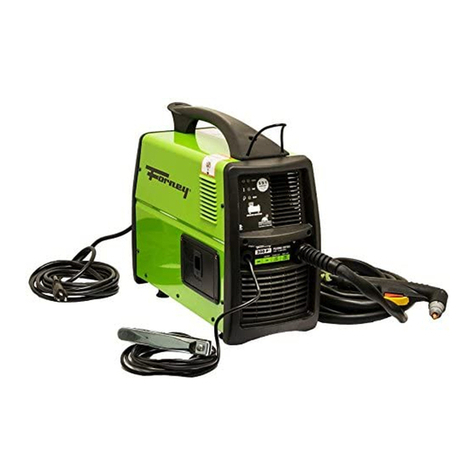
Forney
Forney 250P+ User manual

Forney
Forney 317 User manual

Forney
Forney Easy Weld 140FC-i User manual

Forney
Forney 210 User manual
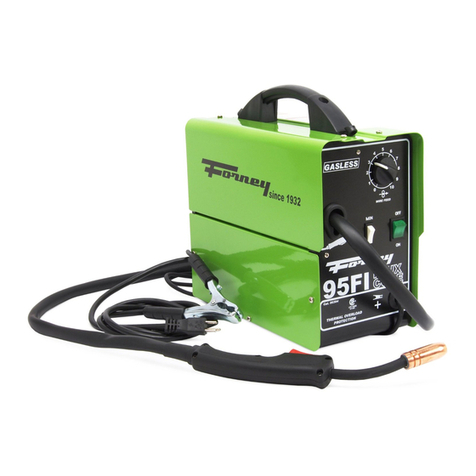
Forney
Forney 95FI User manual
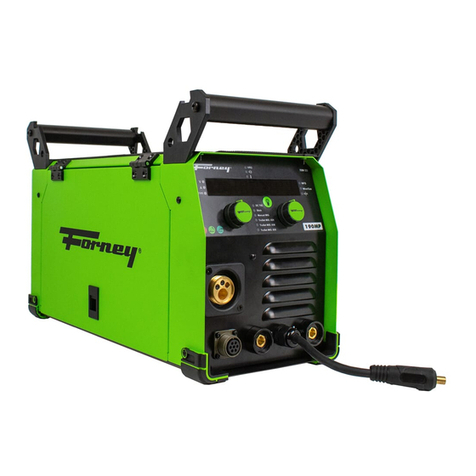
Forney
Forney 190 MP User manual

Forney
Forney EASY WELD 100 ST User manual
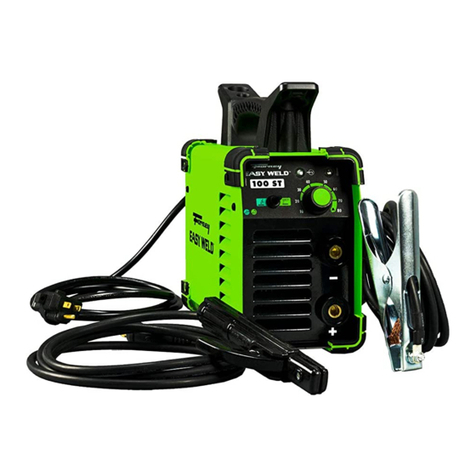
Forney
Forney TIG User manual
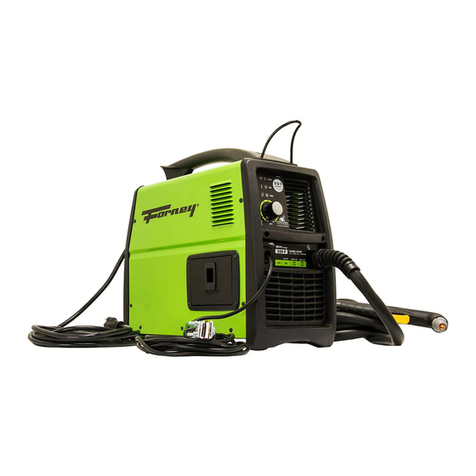
Forney
Forney 325P User manual

Forney
Forney Easy Weld User manual
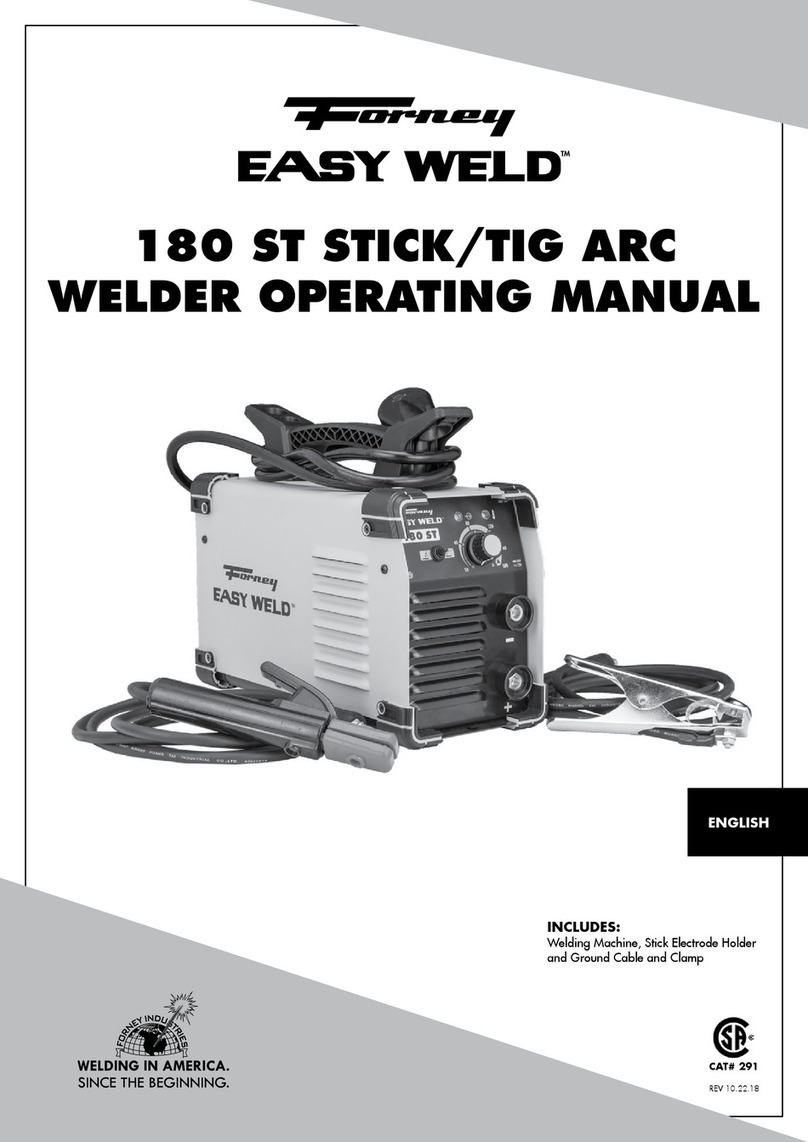
Forney
Forney Easy Weld 180 ST User manual

Forney
Forney 242 User manual

Forney
Forney 220 ST User manual

Forney
Forney 298 User manual
